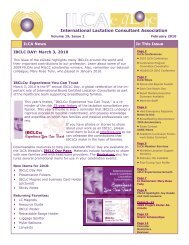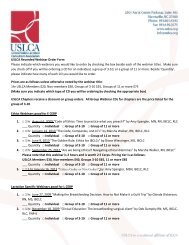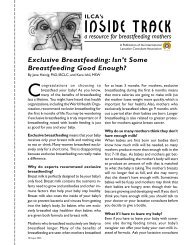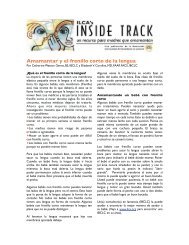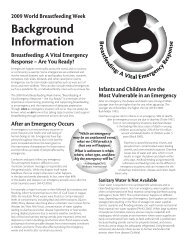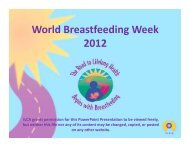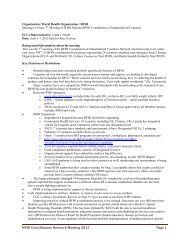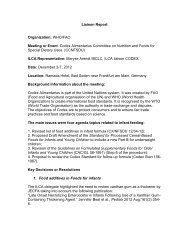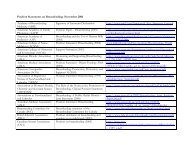2010 - International Lactation Consultant Association
2010 - International Lactation Consultant Association
2010 - International Lactation Consultant Association
You also want an ePaper? Increase the reach of your titles
YUMPU automatically turns print PDFs into web optimized ePapers that Google loves.
Boston University School of Medicine<br />
88 E Newton St, Vose 3<br />
Boston, MA 02118<br />
617-414-6466; anne.merewood@bmc.org<br />
ABSTRACT<br />
Background: Infant feeding information is widespread in the media, through advertising, news,<br />
opinion pieces and instructional articles. The Infant Feeding Practices Study II (IFPS II), was a<br />
US-based longitudinal, mail-in survey conducted by the FDA from 2005-2007, to document<br />
infant practices through year 1 of life.<br />
Objectives: Determine: (1) Exposure among pregnant women to infant feeding information in<br />
the media; and (2) Impact of exposure on breastfeeding behavior in the hospital.<br />
Methods: Exposure and infant feeding status were assessed through questionnaires asked<br />
prenatally and at one month postpartum.<br />
Results: 84% (3959/4688) of pregnant women reported exposure to breastfeeding information<br />
in the media; 90% (4219/4688) reported exposure to formula information and 8% (373/4688)<br />
reported no exposure. More women saw formula information than breastfeeding information in<br />
all media; in TV, 71% of women were exposed to formula but only 34% to breastfeeding<br />
information. In-hospital breastfeeding initiation was 85%; exclusivity was 43%. After<br />
multivariate logistic regression, exposure to breastfeeding information was associated with<br />
increased initiation (AOR 2.64; 95% CI 1.78-3.91) and exclusivity (AOR 1.4; 95% CI 1.03-<br />
1.89); exposure to formula feeding information was associated with lower initiation (AOR 0.43;<br />
95% CI 0.24-0.76); and exclusivity (AOR 0.66; 95% CI 0.45-0.96). The association existed<br />
despite a considerable overlap in exposure.<br />
Conclusion: Prenatal exposure to infant feeding information in the media is strongly associated<br />
with breastfeeding patterns in the hospital.<br />
BANNING THE BAGS: ENCOURAGING TRENDS IN HOSPITAL-BASED FORMULA SAMPLE<br />
PACK DISTRIBUTION<br />
Radha Sadacharan, BA; Xena Grossman, RD, MS; Marsha Walker, RN, IBCLC; Alison Stuebe,<br />
MD, MSc; Melissa Bartick, MD; Amelia Psmythe; Anne Merewood, MA, MPH, IBCLC<br />
The Breastfeeding Center, Boston Medical Center<br />
88 E Newton St, Vose 3<br />
Boston, MA 02118<br />
617-414-6466; radha.sadacharan@bmc.org<br />
ABSTRACT<br />
Background: In 2007, researchers completed a national survey to assess distribution of formula<br />
sample packs in US hospitals. Ban the Bags is a national movement aimed at eliminating sample<br />
pack distribution. In 2009 researchers performed a new study to assess possible changes in<br />
practice.<br />
Objective: To determine whether changes have occurred in sample pack distribution practice<br />
since 2007.<br />
Methods: In 2007, we called all US hospitals to obtain data. In 2009 we relied on self-report:<br />
when a hospital recorded removal of sample packs to Ban the Bags, a research assistant called<br />
the hospital’s maternity service for verification, then added the hospital to the list of “bag free”<br />
sites.





